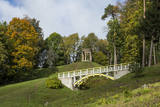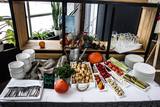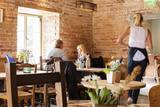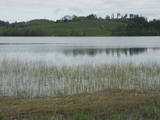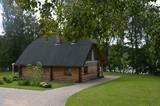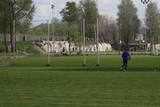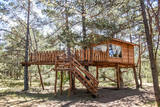| Nr | Name | Beschreibung |
|---|---|---|
|
Saunaland ist ein Dorf voller Saunas, alle zum Geniessen auf unterschiedlicher Weise. Ausser Saunabesuch erfahren sie auch vieles von der Geschichte der Sauna. Es werden Höhlensauna, finnische Sauna, Indianersauna, estnische Sauna, Foliensauna angeboten. |
||
|
Ancient trading routes provided not just goods, but also knowledge and culture. The Light’s rout relates to the Reverent Ernst Gluck, who was a writer, the first translator of the Bible into Latvian, and a founder of Latvian children's schools, the Hernhutian movement of brothers, Kārlis Skalbe, the Kaudzīte brothers, Jānis Poruks, Antons Austriņš and their spiritual heritage. People in Vidzeme bake rye, wheat, barley, spelt and grit bread with various seeds, caraway seeds, nuts, dried fruit and hemp seeds. Hemp is used to produce traditional butter, oil and dumplings made with grey peas. It is also added to candies and even chocolate. Barley flour in the past was used only for celebrations, but today people will teach you how to use it to bake water pretzels with salt and caraway seeds. Visit farms and restored windmills to track the route of grain. Taste traditional Summer Solstice cheese, as well as Green cheese and tasty goat cheese. Pipe perch from Lake Burtnieks is a local delicacy, and you will also find trout, catfish and sturgeon, as well as crabs in season. Local meat and fowl dishes are popular, including dishes made with rabbit. Kitchens at aristocratic estates will offer wild game and pheasants with forest goodies and wild herbs. In Vidzeme you can meet the Garlic Queen, who prepares plant powders. Enjoy pies, sheet cakes, honey cakes, desserts of whipped cottage cheese, mountain ash, quince, apples, sweet cream and rye bread, as well as blackberry or apple dumplings. Slake your taste with herbal teas with honey, birch juice, berry lemonades or, if you're looking for something stronger, some tasty beer or wine. |
||
|
Atrodas Labraga – Apriķu ceļa malā. Kāds nostāsts vēsta, ka to 1896. gadā cēlis vietējais muižkungs, kurš vēlējies, lai viņa meitas laulības notiktu baznīcā. Dievnamā atrodas altārglezna "Kristus pie krusta un Sv. Marija Magdalēna", kas gleznota 19. gadsimtā (autors T. Šprengels). |
||
|
Gegenüber der Marijas Insel (Pilssala) erhebt sich der 30 m hohe und steile (die Abhänge sind künstlich steiler gemacht) Tempelberg – eine alte lettgallische Wallburg mit den Seiteschluchten. Auf einer 80 m langen und bis 40 m breiten Wallburg sind einige künstlich errichtete Wallen zu finden. Eine der ältesten Bezeugungen der Bevölkerungsdichte in der Umgebung des Tempelbergs ist eine gefundene Axt, die aus dem Ende des 3. Jahrtausends und Anfang des 2. Jahrtausends v. Chr. stammt. Archäologen behaupten, dass in dieser Zeit die Pilssala Insel von den Menschen besiedelt wurde. In den 10 – 11 Jahrhunderten befand sich auf der Pilssala Insel eine lettgallische Burg, die 1225 die Kreuzritter vernichtete. Eine Oberfläche der Wallburg wurde relativ kürzlich verändert – 1807 – in der Zeit des Baues einer Granitrotunde. Die Rotunde wurde zu Ehren des russischen Feldmarschalls Scheremetjew und des schwedischen Kapitäns Wolff errichtet. Ein Blick vom Tempelberg auf den Alūksne See und die Stadt ist einer der schönsten in Livland! Besuchenswert sind eine 1937 errichtete Sonnenbrücke, sowie ein unweit vom Tempelberg liegender Holzaussichtsturm. |
||
|
The restaurant offers a range of delicious and healthy meals from a range of international dishes with a wide variety of drinks, freshly baked biscuits, truffles, cakes and seeded breads are also available with lunch or dinner meals. There is a special daily offer available on weekdays and ability to organize a range of themed events, all catered for with food, drink and our freshly baked goods. A children’s menu is available for younger guests as well as playroom and a playground located next to the windmill. |
||
|
Diese Tour führt Sie durch die eigenartige Insel von Rusnė und das Mündungsdelta des Flusses Nemunas in Litauen. Die Insel Rusnė im Regionalpark der Nemunas- Mündung ist vom Wasser des Flusses Nemunas (Memel) und seiner Nebenflüsse umgeben. Es ist ein Rastplatz für Zugvögel und Heimat einer Kormoran Kolonie. Die Fläche der Insel beträgt 45 km2 und die Insel ist mit dem Festland durch eine Brücke verbunden. Die Insel Rusnė ist der tiefste Ort in Litauen und liegt unter dem Meeresspiegel. Das historische Zentrum der Stadt Rusnė zeichnet sich durch authentische Holzarchitektur, in hellen Farben gestrichene Gebäude, bunte Fensterläden und Dekorationen aus. Der baltische Küstenwanderweg führt durch die kleine Stadt Šilute, wo Sie dem ehemaligen Ostpreußen charakteristische Architektur bewundern können. Von Šilutė nach Kintai ist das Gelände des baltischen Küstenwanderwegs eher flach. Um dieses Gebiet vor dem Hochwasser von Nemunas zu schützen, wurde ein System von Dämmen, Poldern und Kanälen errichtet. Nach der Überquerung des Flusses Minija lädt die Route zu der ethnographischen Siedlung von Minija ein. Hier können Sie die Niederungslandschaft der Küstenregion mit weiten Feuchtgebieten und Teichen genießen. |
||
|
Ungru Resto ir piejūras restorāns Hījumā ziemeļu krastā, kur atmosfēru rada kādreizējā muitas māja, Suursadamas vide, kvalitātīvs ēdiens un apkalpošana. Ēdienkartē tiek izmantotas vietējie produkti un tiek gatavoti tradicionālie Hījumā salas ēdieni, pasniegti mūsdienīgā stilā. Restorāns Ungru Resto - iesaka White Guide 2018. |
||
|
Dieser Park wurde eingerichtet, um die Burzava Hügel, den See Adamova (ein eutrophischer See) und die Biotope und Arten, die man entlang seiner Ufer - einschließlich der Fledermäuse - findet, zu schützen. Den schönsten Blick über das Gebiet hat man von den Hügeln des Nordufers des Sees. Hier gibt es Unterkünfte an den Ufern des Adamova-Sees, wo Touristen die Nacht verbringen können.
|
||
|
The holiday houses are located near Lake Ieva, 30 m from the lake shore. On the 1st floor of the holiday house - lounge with fireplace and glazed veranda, sauna (50.00 EUR / evening), small kitchenette, toilet. Outside-small terrace overlooking the lake. On the 2nd floor there are 2 isolated rooms and 10 beds. By the lake - a fireplace, a well-groomed swimming area with a footbridge. Boats and catamarans can be rented. |
||
|
Gebaut im Jahre 1835 als Eigentum der Barone von Fircks nach Bestellung der Baronesse Tea von Fircks. Nach einem Umbau in 1883 erhielt das Gebäude ein herrschaftlicher Dekor im Stil der Renaissance und im manieristischen Stil und größerer Umfang des Baues. Am 15. Dezember 1905 wurde das Gebäude des Landguts von Revolutionären in Flammen gesetzt. Drei Jahre später fingen die Wiederherstellungsarbeiten unter der Leitung vom Architekt L. Reinīrs an. Im Gutsschloss sind eine Festhalle mit zwei Kaminen aus Marmor, in den Einzelräumen – ein am Anfang des 20. Jahrhunderts gelegtes Parkett und Außentürflügel mit Metallprägung zu besichtigen. 1938 wurde das Schloss umgebaut. In der Zeit des Zweiten Weltkriegs befand sich im Gebäude ein Kriegslazarett der deutschen Armee, aber nach dem Krieg – eine Schule für die Waldarbeiter. Seit 1962 befindet sich im Schloss die Schule von Rudbārži, die den Namen von Oskars Kalpaks trägt. An der Wand des Gebäudes befindet sich eine Gedenkplatte zu Ehren des Kalpaks-Bataillons. Am 22. Januar 1919 haben die Bolschewiken während des Lettischen Unabhängigkeitskriegs die Stadt Skrunda eingenommen. Sieben Tage später wurde das Kalpaks-Bataillon vom Landgut Rudbārži aus Richtung Skrunda angetreten. Nach einer dreistündigen Schlacht hat das Bataillon den Sieg behalten und eine strategische Position in der Nähe des Ufers des Flusses Venta eingenommen. Es war ein erster Sieg des Bataillons nach den mehrmaligen Rückzügen und es regte zu den weiteren Kämpfen an. |
||
|
An der rechten Uferbiegung an der Mündung der Inčupe erhebt sich die bis zu 18 m hohe weiße Düne, die malerischste Ausgestaltung von Wind, Sand und Meer an der Küste der Rigaer Bucht - ein alter Orientierungspunkt der Seefahrer. Ein Stegpfad mit Aussichtsplattform. Das Gebiet südlich von Inčupe liegt im Naturpark Piejūra.
|
||
|
Ein kleiner Teil von dem beeindruckenden Fortifikationssystem von Liepāja, das die Stadt die Küste der Stadt umgibt. Er befindet sich am Stadion „Olimpija”. Siehe auch die Objekte Nr. 30077, 30078, 30079, 30080, 30098.
|
||
|
Aiz Jodkrantes (Nidas virziens) ceļa labajā pusē ir izveidots autostāvlaukums un labiekārtota vieta, no kuras apskatāma Lietuvas (atrodamas ziņas, ka arī Eiropas) lielākā zivju gārņu Ardea cinerea un jūras kraukļu Phalacrocorax carbo kolonija, kur kopā varētu būt ~ 3000 putnu. Neaizmirstiet līdzi paņemt tālskati! |
||
|
Haapsalu was once loved by aristocrats who stayed here during summers, nowadays this town is very appealing to its visitors because of its essence - tiny streets, old wooden buildings and promenade. Worth mentioning are also town's SPAs which were one of the reasons why Haapsalu was so popular its earlier years. Interesting enough, the famous composer Tchaikovsky considered this place one of his favorite's for spending the holidays. |
||
|
Camping, sauna by the sea, picnic places, rest in a romantic wooden house and accommodation in tents, canopy rental, rental of places for outdoor events. |
||
|
Um den Fluss Daugava aus einer anderen Sicht zu sehen, kann man vom Bäckerei-Geschäft der Firma „Liepkalnu maiznīca” eine Ausfahrt mit einem Langschiff der Wikinger „Lāčplēsis” machen, der gleichzeitig eine Gruppe von 24 Personen an Bord aufnehmen kann. Daugava war schon von alters her ein bedeutender Wanderungskorridor nicht nur für verschiedene Pflanzen- und Tierarten, die dadurch auf das jetzige Territorium Lettlands “gekommen” sind , sondern auch für Leute und Stämme, die die Daugava-Ufer und die Ostseeküste besiedelten. |
||
|
Pirms dodamies tālāk – Skaistkalnes virzienā, var izmest nelielu loku līdz Lejeniekiem, kas atrodas skaistā vietā – Mēmeles kreisajā krastā, 6 km austrumos no Bauskas. Latviešu dzejnieka Viļa Plūdoņa (1874. – 1940.) memoriālais muzejs dibināts 1968. g. viņa dzimtajās mājās „Lejeniekos”. Zemgales daba un vecmātes stāsti būtiski ietekmēja nākamā dzejnieka daiļradi. Šeit nokļuvušie var apskatīt ratu un etnogrāfisko priekšmetu kolekciju, izstaigāt Plūdoņa taku vai apmeklēt dzejnieka un viņa radinieku atdusas vietu netālu esošajos kapos. Bērniem noteikti jāiegriežas “Zaķīšu pirtiņā”. |
||
|
Die Autoreise von Vilnius nach Rīga führt Sie zu den schönsten und wichtigsten Sehenswürdigkeiten des Wald-Wanderweges in Litauen und seinem südlichen Teil in Lettland. Sie beginnen Ihre Tour mit dem Besuch der Hauptstadt Vilnius, dann fahren Sie zu der historischen Kurstadt Druskininkai, und danach wandern Sie auf dem städtischen Abschnitt des Wald-Wanderweges. Danach werden Sie den Nationalpark Dzūkija, den Merkinė-Burghügel und die Kurstadt Birštonas besuchen, die sich im Memelschleifenregionalpark befindet. Weiter erreichen Sie die zweitgrößte Stadt Litauens – Kaunas – und wandern durch die Stadt entlang der Route des Wald-Wanderweges, um schließlich den Wald von Panemunė zu erreichen. Anschließend führt die Der nächste Teil der Route umfasst den Regionalpark Dubysa mit dem spektakulären Dubysa-Flusstal, historischen Kirchen und mehreren Burghügel entlang der Flussufer. Das Gelände kann Sie mit einer anstrengenden Wanderung überraschen. Anschließend besuchen Sie die Stadt Šiluva, die ein katholischer Wallfahrtsort ist, und fahren dann zum Regionalpark Tytuvėnai, wo Sie den Naturpfad des Sees Gilius, der Teil des Wald-Wanderweges ist, erkunden. Die Tour geht weiter im Regionalpark Kurtuvėnai, wo Sie einen Abschnitt des Wald-Wanderweges von Kurtuvėnai nach Šaukėnai entlang kleiner Waldwege, Lehrpfade, schöner Baumalleen und durch Feuchtgebiete wandern. Dann fahren Sie zu der Region Žemaitija, besuchen die Stadt Telšiai und wandern einen Abschnitt des Wald-Wanderweges entlang des Plateliai-Sees. Anschließend führt Sie die Tour durch die steinerne Stadt Mosėdis nach Lettland, wo Sie eine Pause machen und einen Spaziergang durch eine der ältesten Städte Lettlands machen – Aizpute. In dieser Stadt empfehlen wird die Holzarchitektur aus dem 19. Jahrhundert und die lokale Weinbrauerei zu genießen. Weiter werden Sie für eine kurze Strecke des Wald-Wanderweges im herrlichen Gutspark Kazdanga wandern und danach weiter zu der schönsten Stadt Kurzeme – Kuldīga – fahren. Am Ende der Tour wandern Sie einen Teil des Wald-Wanderweges im Naturpark des Abava-Flusstals und entlang der Pfade im Nationalpark Ķemeri. |
||
|
Das Café befindet sich im Gästehaus Pils, am Burgberg der Ritter und am Pulverturm, die man aus der Sommerterrasse des Cafés sehen kann. Lettische Küche: Dickflüssige Erbsensuppe, Suppe aus hausgemachten Frikadellen, cremige Steinpilzsuppe, kalte Rote-Beete-Suppe, gebratenes Schweinefleisch, hausgemachte Frikadellen, gefüllte Flunder, Kartoffelpfannkuchen, geschichtetes Roggenbrot-Dessert. |
||
|
This is certainly the thickest White Willow (Salix alba) in Latvia and perhaps the thickest one in the Baltic States. Many of its mighty branches are resting on the ground, and the enormous monolithic trunk has been split. There’s a small information stand alongside the tree. A pathway which starts at the Raganu cliffs can be taken to the tree.
|
||





